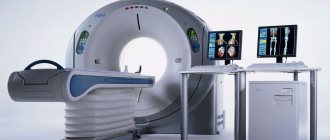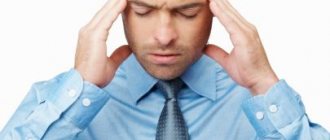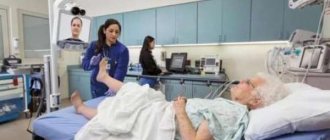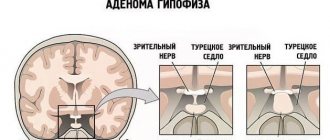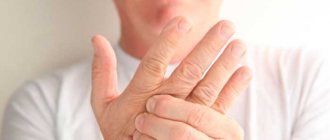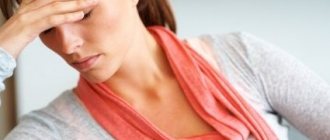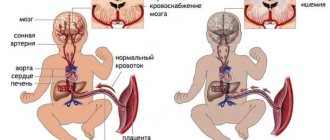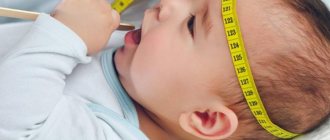Stroke is a terrible disease that can easily leave a person bedridden or even take his life.
Around the world, about 600 people per 100,000 inhabitants fall victim to this insidious pathology every year.
It happens that a person suffers a stroke on his legs and does not notice it, but more often the disease, on the contrary, can make him disabled.
It is believed that this pathology occurs suddenly, but not everyone knows that a stroke has warning signs. How to predict that a person is at risk of this disease, and how to avoid it if alarming symptoms are noticed in time?
Types of stroke
A stroke is literally translated as a sudden jump. Sudden illnesses indicate a sharp disruption of cerebral circulation. Brain stroke can be ischemic or hemorrhagic.
Ischemic stroke
Characterized by a sudden lack of blood flow to the brain. This type of disease is the most common, accounting for 80% of all cases of its manifestation. The ischemic form of the pathology is accompanied by softening of a section of brain tissue. This condition is called cerebral infarction. Cerebral ischemia is reversible, depending on the depth and duration of the decrease in cerebral blood flow.
Hemorrhagic stroke
Not the most common type of disease, in which one or more areas of the brain fill with blood. Approximately every fifth stroke is hemorrhagic. It is divided into two more subtypes, which differ from each other in the location of the hemorrhage. In the first case, a vessel ruptures directly in the tissue, in the second, a vessel ruptures under the membranes of the brain.
Interesting fact! Damage to cerebral vessels in women under 50 years of age occurs much less frequently than in men of the same age group.
Pre-stroke condition: symptoms in women and men, treatment, consequences
Not a single acute cerebrovascular accident (ACVA, stroke) occurs by chance.
A life-threatening condition always has a prehistory, and it is not necessarily a chronic, severe illness. Sometimes strokes occur against a background of stress or physical strain, and they are almost always based on incorrect prioritization. A person neglects his health, ignores painful symptoms due to being too busy at work or in the family, and sometimes simply does not take care of himself.
We invite you to talk about what a pre-stroke condition is, how it manifests itself, and what to do to avoid trouble.
Possible reasons for development
There are two types of stroke: hemorrhagic and ischemic (cerebral infarction).
Hemorrhagic stroke occurs as a result of a rupture of a cerebral vessel or a partial violation of its integrity, in which blood begins to leak through the wall of the vessel. In medical terminology, this condition is called cerebral hemorrhage.
An ischemic stroke is caused by a temporary blockage of arteries in the brain, as well as large arteries such as the carotid or vertebral arteries.
As a result, oxygenated blood stops flowing to a certain area of the brain.
Most often, the blockage of blood flow is associated with a blood clot or atheroma, which, together with the bloodstream, enters the narrow vessels and arteries of the brain, completely blocking their patency.
If incomplete blockage of the vessel occurs, then this condition is temporary and, with emergency treatment, reversible. It's called a transient ischemic attack.
At this time, a person begins to experience characteristic symptoms that precede a future stroke. Unlike a stroke itself, a transient ischemic attack does not cause serious brain damage, but is still very dangerous.
It is impossible to establish a reliable reason why at some point a blood clot or atherosclerotic plaque breaks off and enters the general bloodstream.
There is an assumption that this occurs under the influence of factors that provoke a jump in blood pressure and spasm of the arteries of the brain:
- temperature effects (overheating, heat stroke, hypothermia);
- consumption of drinks containing ethyl alcohol;
- severe emotional shock;
- prolonged exposure to stress;
- physical exercises performed with high frequency and large amplitude.
In addition, a pre-stroke condition includes a hypertensive crisis and its complication – hypertensive encephalopathy. They can be caused by a sharp sudden increase in blood pressure as a result of advanced hypertension, eclampsia, nephritis in the acute stage and other serious diseases.
Dangerous symptoms of pre-stroke
Two conditions are precursors to strokes: transient ischemic attack (TIA) or hypertensive crisis. The symptoms of both pathologies overlap with each other, but there is an important difference - with TIA the patient always loses consciousness, with a hypertensive crisis this rarely happens. It also matters how long the TIA lasts.
If the duration of the attack exceeds a day, the attack almost always ends in a stroke. In case of a hypertensive crisis, the scenario is slightly different - if the attack can be stopped quickly, there is no need to fear a stroke. If the rise in blood pressure occurred suddenly and first aid was not provided to the patient in a timely manner, the next step may be a stroke.
Important: Episodes of TIA are a warning to the patient about the threat of a stroke. A stroke can occur within 5 years after the attack.
The clinical picture of pre-stroke directly depends on the ischemic or hemorrhagic type of future circulatory disorder.
Ischemic type
Let's look at what symptoms determine the pre-stroke condition, in which treatment is aimed at eliminating ischemia.
Symptoms of ischemic pre-stroke increase gradually and occur in people over 50 years of age. Here are the most common manifestations:
- speech disorders - a person confuses syllables, pronounces words unclearly, or cannot speak at all,
- pronounced pallor of the skin and severe joint weakness,
- asymmetry of the face, its numbness - the corner of the mouth drops, the tongue deviates to the side,
- weak pulse filling and chest pain,
- double vision, monocular blindness.
Important: This symptomatology is possible against the background of normal blood pressure and temperature.
Hemorrhagic type
Unlike ischemia, hemorrhagic pre-stroke is characterized by a sudden onset. The following symptoms are observed:
- severe weakness or motor agitation,
- sudden fainting,
- sudden changes in emotional state - sudden joy, depression, rage,
- involuntary movements - the patient slaps his hand on his body, waves his hands, etc.,
- heavy sweating,
- severe hyperemia, bluishness of the face or, on the contrary, severe pallor,
- convulsions,
- difficulty breathing.
Features of age and gender
As we noted earlier, in pre-stroke conditions, symptoms occur more often in men than in women. The most common age group is working men over 45 years of age, but under 60 years of age.
If a person does not have the chronic pathologies that we described above, the development of the disease is associated with previous intense physical work and bad habits.
Often, a pre-stroke condition develops as a complication of alcohol withdrawal or alcohol withdrawal syndrome.
Signs of a pre-stroke condition rarely occur in women of reproductive age. More often, the attack begins in elderly women who have crossed the 60-year mark. In the postmenopausal period, women develop vascular pathologies, the level of cholesterol in the blood increases, and arterial hypertension appears, which leads to pre-stroke.
It is hardly reasonable to talk about the isolation of symptoms and consider some signs only male, and others only female. The type of condition matters - ischemic or hemorrhagic and the presence of concomitant pathologies.
Who is at risk?
Most often, stroke is diagnosed in older people over 50 - 60 years old, but it can also happen in young people. That is, in fact, at any age.
The risk group with a predisposition to vascular accidents includes people suffering from:
- high blood pressure (hypertension);
- heart rhythm disturbances;
- diabetes mellitus;
- pathologies of the blood coagulation system;
- obesity (especially abdominal type);
- low mobility;
- diseases accompanied by high cholesterol levels;
- abnormalities in the development of cerebral vessels;
- alcohol and nicotine addiction.
Treatment
It is carried out using several methods. There are three tasks. Relieve symptoms and residual signs, eliminate the root cause and prevent relapses.
Drug correction involves the use of the following drugs:
- Antihypertensives if there is a stable increase in blood pressure. ACE inhibitors, beta blockers, calcium antagonists, centrally acting agents, diuretics with a mild potassium-sparing effect.
- Statins. For the rapid removal of cholesterol and the elimination of already formed plaques, provided that they have not hardened due to calcium salts. Atoris as the main one.
- Anticoagulants and antithrombotic. Eliminate blood clots. They are not allowed to form. Restore the fluidity and rheological properties of liquid connective tissue. Heparin or Aspirin-Cardio.
- Angioprotectors. Protects blood vessels from destruction.
Other medications as indicated. If medications are ineffective or obviously ineffective, surgical treatment is prescribed.
It is mainly needed for advanced atherosclerosis, vascular defects, such as congenital anomalies or aneurysms, and other processes.
Source: https://neuro-orto.ru/bolezni/ynsult/predynsultnoe-sostoyanie.html
Risk factors for stroke
People predisposed to stroke are often unaware of their dangerous situation. Most often these are people who are prone to obesity, lead an unhealthy lifestyle, and are genetic heirs of cardiovascular diseases. There are several factors that influence the likelihood of developing the disease:
- smoking;
- alcoholism;
- stress;
- genetic predisposition;
- atherosclerosis;
- cerebral aneurysm;
- intracranial pressure;
- hypertension;
- cardiovascular diseases;
- diabetes;
- blood clots;
- excess weight.
These factors should prompt any person to think about a healthy lifestyle, timely medical examinations, and reviewing their diet. People whose closest relatives have suffered a stroke should be especially careful about their health, since possible pathologies are already embedded in their DNA.
Causes
Acute cerebral circulatory disorders occur as a result of blockage of the vessels responsible for cerebral circulation (an ischemic type of pathology develops), or as a result of a sudden rupture of a vessel (hemorrhagic type).
Ischemic stroke in men and women occurs as a result of arterial hypertension and atherosclerosis. Common factors for both sexes that cause hemorrhagic stroke: arterial or arteriovenous aneurysms, hypertension.
What causes it in men?
The causes of stroke in men are often alcohol abuse and smoking. These bad habits cause surges in blood pressure, prolonged vasospasm, resulting in heart disease and degenerative processes in the cerebral vessels. In addition, the pathological condition is caused by stress, poor diet and excess weight, metabolic disorders, as well as age-related changes against the background of the progression of somatic diseases.
In men over 65 years of age, the main causes of the disease are arterial hypertension and high cholesterol.
Why does it occur in women?
Diseases of the cardiovascular system, endocrine pathologies, severe concomitant somatic disorders and infections are the main causes of stroke in women. This disease mainly affects women over 60 years of age. However, cases of its development in middle-aged women are increasingly being recorded. The ischemic type of pathology often occurs at 18-40 years of age.
Factors that can trigger a sudden stroke include:
- Long-term use of oral contraceptives.
- Pathological course of pregnancy.
- Predisposition to blood clots due to hormonal imbalance and menstrual bleeding.
- Often occurring migraine attacks against the background of spasm of cerebral vessels.
Increased emotionality, constant mood swings and low resistance to stress are also prerequisites for pathology. In addition, stroke often occurs from addiction to bad habits. Smoking provokes vasospasm and intoxication of the body, contributes to the development of ischemic heart pathology and degenerative processes in cerebral vessels.
In older women, the main causes of the disease are:
- Atrial fibrillation.
- Narrowing of the carotid arteries.
- Cardiac ischemia.
- Cardiovascular failure.
Symptoms of a stroke
According to statistics, the disease manifests itself at night or early in the morning. The patient may feel an impending stroke. The primary symptoms are: severe numbness in one half of the body, a feeling of a rush of heat, speech deteriorates, it becomes difficult to pronounce even simple words, vision deteriorates, especially on one side, gait becomes unsteady, coordination of movements is impaired, the patient feels a severe headache, even vomiting. At the same time, the pulse decreases, breathing quickens, and the person blushes.
There are a number of symptoms that indicate a clear picture of pathology:
- Ask the person to smile. One side of the lips will remain motionless.
- Talk to the patient. His speech will be incomprehensible and confused.
- The patient will not be able to stick out his tongue completely. It will be asymmetrical or motionless.
- Raised both hands of a person will not be symmetrical.
- Outwardly, a person may look scared, and consciousness is often confused.
- A person affected by a stroke may experience sudden hearing loss.
- Complete cardiac and respiratory arrest is possible.
- Even at rest, facial asymmetry can be observed.
- Trembling of the limbs or one half of the body.
- Uncontrolled urination or bowel movements.
A number of these symptoms require emergency medical attention for the patient. If you witness a stroke, call an ambulance immediately, a person’s life counts in minutes.
Precursors of stroke
It is almost impossible to prevent a stroke, since the warning signs of the disease are rarely bright or do not cause much concern in the patient, however, a person may periodically feel unwell long before the disease. Hypertensive patients are the main targets of stroke. If a person periodically spasms blood vessels, then the nutrition of the brain is already impaired, and the combination of this condition with stress is extremely dangerous. That is why every self-respecting person needs to know the symptoms of an impending stroke:
- hypertensive crisis. At the peak of high blood pressure, ischemic stroke occurs, so if pressure increases, urgent measures must be taken;
- weather sensitivity. She talks about weak blood vessels and poor circulation. Blurry headaches due to wind or changes in atmospheric pressure should alert you;
- dizziness, which often occurs when changing body position or walking quickly;
- noise in ears;
- short-term memory lapses.
These are the main warning signs of a stroke. Sometimes they last for years, which means it is impossible to predict exactly when an attack will develop. Knowing the signs of an impending stroke, you can seek help in time to avoid a terrible outcome.
Prevention of stroke in men
Having discovered the first symptoms of a stroke, it is necessary to place the patient on an elevation and raise his head 30 degrees, then provide an influx of fresh air, remove clothes so as not to restrict the movement of the chest. Next, you need to measure the pressure; if it increases, give the patient the necessary medication or put his feet in hot water. The head should be turned to the side so that vomit does not enter the respiratory tract. If you vomit, try to clear your mouth of stomach contents as best you can. Call an ambulance immediately.
To prevent the development of stroke, you should completely change your usual lifestyle: increase physical activity and completely eliminate bad habits. It is still necessary to undergo an examination that will help determine the main cause that caused the circulatory disorder in the brain, as well as eliminate the disease that led to the stroke.
Try to avoid stress and depression, and reduce mental pressure. Meditation and self-hypnosis are very helpful for this. Evening walks in the fresh air, proper rest and taking medications containing potassium and magnesium are recommended. You should exclude fatty foods from your diet and limit the consumption of sweets, jam, sugar, potatoes and bread. Cycling, swimming and skiing are effective for the body. However, such loads should be discussed with your doctor. Taking into account your health indicators, he will prescribe the appropriate level of physical activity.
Main signs of stroke and mini-stroke
Hemorrhagic stroke leads to a sudden loss of consciousness at the moment of damage to the vessel and the onset of hemorrhage. In severe cases, cerebral coma occurs, in which hemorrhage occurs in the ventricles of the brain. This condition is fraught with instant death.
The area of brain damage indicates a number of individual abnormalities. For example, if the parietal part of the brain is damaged, the smile becomes distorted, the eyelid becomes immobilized, and one side of the body becomes noticeably weaker. Stroke damage to the temporal lobe leads to speech impairment, forgetfulness, and problems with spelling.
When other parts of the brain are affected, swallowing is impaired, coordination of movements becomes difficult, urination and bowel movements become uncontrollable. With minor cerebral ischemia, drowsiness and stupor are observed, and speech functions are impaired, but only slightly.
With a microstroke, all the signs are much weaker than with complete cerebral ischemia. Blood circulation is disrupted, but after 15-20 minutes it is restored, leaving a small trail of symptoms that can remain with a person for life. For example, a patient who has suffered a mini-stroke may suffer from memory loss for a long time or cannot pronounce certain words.
Focal
Several regions of the brain can be distinguished. Based on this typification, they talk about a number of symptomatic groups.
Frontal lobe
Responsible for a lot of important functions. Local manifestations are severe and disabling:
- Violation of cognitive, mnestic activity. The patient is unable to solve simple logical problems. Confused about basic facts and moments. Productivity drops sharply, often to zero. The disruption of normal neural connections and impulses affects. Depending on the quality of first aid and treatment, the patient may have a chance of full recovery.
- Relapse into childhood, regression of the intellectual component. Primary reflexes, which are present immediately after birth, are restored. Sucking, grasping. There is a complete lack of adequacy. The reaction to external stimuli is atypical for the patient’s age. This option occurs rarely, in no more than 2-3% of cases.
- Behavioral deviations. But the violation of this component of the human personality forms the basis of the focal symptoms of this localization. The main character traits are emphasized. Unmotivated aggressiveness, playfulness and foolishness, other moments. All behavioral reactions do not correspond to the environment and situation, which makes normal interaction with a person impossible.
- Paralysis of the side of the body opposite to the lesion. Inability to control limbs. The face also suffers. Mimic muscles. This is a possible differential sign and early detection method for stroke.
- Epileptic seizures of a generalized plan. Tonic-clonic (whole body) seizures occur. The syndrome is accompanied by spontaneous strong muscle contractions that cannot be relieved by first aid. A few minutes later, the man regains consciousness. The episode is likely to recur, which is considered a negative prognostic sign.
Parietal lobe
Responsible for the tactile sphere and some other higher nervous functions.
- The first sign of an incipient stroke is complex hallucinations. Covers all senses. Therefore, they create illusory images that are difficult to distinguish from reality.
- Lack of smell on one side. It does not always occur and not in all patients.
- Loss of the ability to read, perform simple arithmetic operations, and write. Temporary phenomenon.
Caused by disruption of already formed neural connections. This symptom does not show persistence, except in exceptional cases. As part of rehabilitation, the issue can be effectively resolved.
- Tactile hallucinations. Sensation of touching, crawling under the skin. The so-called senestopathy. At the same time, the person fully retains criticism of the condition, which distinguishes stroke from mental disorders.
- Lack of perception of one's own body as a whole. The patient may not perceive the arm, leg, or fingers as his own. At the same time, he senses individual segments well.
- The inability to identify by touch an object that a person knows. With my eyes closed. The form seems unclear. This is the result of the same lack of integrity of perception. There is no synthesis of individual elements or characteristics of an object.
Temporal lobe
Consciousness, hearing, memory and other components of higher nervous activity. All this is “concentrated” here.
- Lack of ability to recognize native speech. A person formally perceives a stimulus. But he can't understand a single word. This is similar to passive learning of a foreign language.
- Complete deafness or lack of hearing in one ear. Temporary. Functions are gradually restored, although not always fully.
- Epileptic seizures. Not as severe as with damage to the frontal lobes. They last slightly less and rarely recur within one episode of acute cerebrovascular insufficiency. Otherwise, the signs are identical. Loss of consciousness, convulsions.
- Verbal pseudohallucinations. Like the notorious voices in my head. Usually they comment on the victim’s behavior or talk about abstract topics without addressing the patient. A person retains criticism and understands that this is a painful manifestation.
- Various types of amnesia. Anterograde (when the failure occurs at the time from the onset of the pathological process to recovery), retrograde, global, selective and others. Depends on the extent of the lesion and location.
Occipital lobe
Responsible for processing visual information.
- Fog in sight. It always shows up. Considered a typical manifestation. Does not go away on its own.
- Scotomas. Loss of individual areas. Appears as a black spot in the central or so area. Also found along the periphery.
- Photopsias. The simplest visual hallucinations. Like flashes of light, lines, geometric shapes.
- Metamorphopsia. Inability to clearly assess the distance to an object or its size. False illusory conclusions are possible. The sign clearly indicates a non-neurological origin of the symptom. Because the eye itself cannot process anything. This is a function of higher activity that is performed by the brain.
- Blindness in both eyes or on one side. Cortical. Usually transient.
Extrapyramidal structures (cerebellum)
Nystagmus (spontaneous oscillations of the eyeballs to the right and left), inability to control one’s own movements, disorientation, awkwardness, muscle rigidity (tension).
Brain stem
Breathing disorders, heartbeat (even stopping), temperature surges or persistent rise to critical levels. Also complete paralysis, lack of motor activity and speech.
First aid to a patient
If it happens that you have witnessed a stroke, then first of all call an ambulance. Before doctors arrive, you can provide first aid that will save a person’s life.
First of all, provide oxygen access. Open all the windows, unbutton the patient's tight clothing. Lay the person down so that their head is slightly higher than their body. Try to measure his blood pressure; if the numbers are critical, give him an antihypertensive drug, but only if it was previously prescribed by a doctor. When the ambulance arrives, tell us about the medications you gave to the patient.
If the patient is unconscious, then also place him on a hard surface and turn his head to the side. This position will prevent aspiration of the lungs during vomiting. Do not give the person any injections or give any other forms of medicine. Until the ambulance arrives, do not leave the patient, make sure that breathing and pulse remain normal. If the heart stops, resuscitation can begin. If convulsions occur, you need to unclench the patient’s jaw with a spoon and move the tongue away so that it does not fall back. Until the cramps stop, you need to move the lower one forward a little.
Diagnosis of the disease
Timely diagnosis helps save lives. It is very important to undergo medical examinations on time, and at the first worrying symptoms, consult a doctor. An external examination helps determine the signs of a stroke, and instrumental methods allow you to find the focus and determine the severity of the disease. At the same time, other pathologies similar to stroke symptoms are excluded.
At the patient's request or for a fee, a computer or magnetic resonance imaging scan can be performed. This method is the most popular and helps to identify any changes in the vessels and structures of the brain and other organs. In this way, you can not only monitor the course of the disease, but also prevent impending disaster.
Using functional diagnostics, blood clots and sclerotic lesions of blood vessels and heart valves are identified or excluded. Laboratory examinations of the patient help to study the patient's blood, its clotting and composition. Most often, the disease develops in patients with thick blood. Biochemical laboratory parameters help track cholesterol levels, which is also the culprit of many vascular disorders.
Traditional medicine for recovery after a stroke
The signs and consequences of a stroke in a man can be overcome not only using traditional medicine methods, but also folk remedies. But their use must be agreed upon with the attending physician. Folk recipes are based on the beneficial properties of herbs and certain products.
Among them the following funds can be distinguished:
- Arnica infusion improves blood circulation in the brain and helps regulate cholesterol levels. To prepare it, you need to pour 10 g of dried flowers into a glass of hot water, bring the mixture to a boil and leave for 1-2 hours. The strained infusion is drunk before each meal, 1 tbsp. l. The product can be diluted with milk in a 1:1 ratio.
- Speech and memory disorders are treated with sage decoction. Place 1 tbsp in an enamel bowl. l. crushed dry or fresh raw materials, pour 250 ml of hot water and bring to a boil over low heat. The container with the decoction is wrapped and left to infuse for 1 hour. The product, sweetened with a small amount of honey, is drunk 100 ml 10 times a day.
- To prevent a recurrent stroke, drink rosehip tea. It thins the blood and saturates the body with vitamins and minerals. To prepare a drink that can be drunk without restrictions, rose hips are crushed, placed in a teapot and poured with boiling water. They are infused for 20-30 minutes and drunk in unlimited quantities.
- Paralysis of the limbs is an unpleasant symptom of a stroke, which causes a lot of inconvenience to the patient. Oil from laurel leaves, pine needles and vegetable oil will help overcome paralysis. 30 g of bay leaves and pine needles are crushed using a blender. The resulting slurry is poured with 250 ml of any vegetable oil (olive, sea buckthorn, castor, avocado oil). The container is closed and left for 2 months in a dark place, periodically shaking its contents. Then the mixture is filtered and brought to a boil. The oil is rubbed on the paralyzed parts of the body.
- One of the goals of the rehabilitation period after a stroke is to prevent another attack. For this purpose, you can take a remedy made from cranberries, onions and lemon daily. Using a blender or meat grinder, crush the cranberries into a pulp and combine with 1 liter. honey. The resulting mass is infused for 1 week. Then a paste is made from onions and unpeeled lemons and combined with a mixture of cranberries and honey. The product is infused for 10 days. It should be taken after breakfast, 1 tbsp. l., washed down with a hot drink.
Men who have suffered a stroke and their loved ones need to remember that traditional medicine is an addition to the main treatment and is taken under the supervision of a physician.




